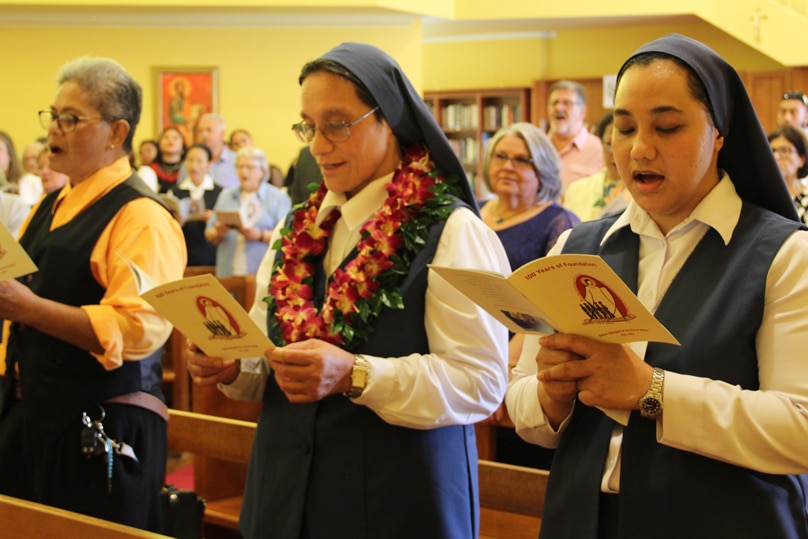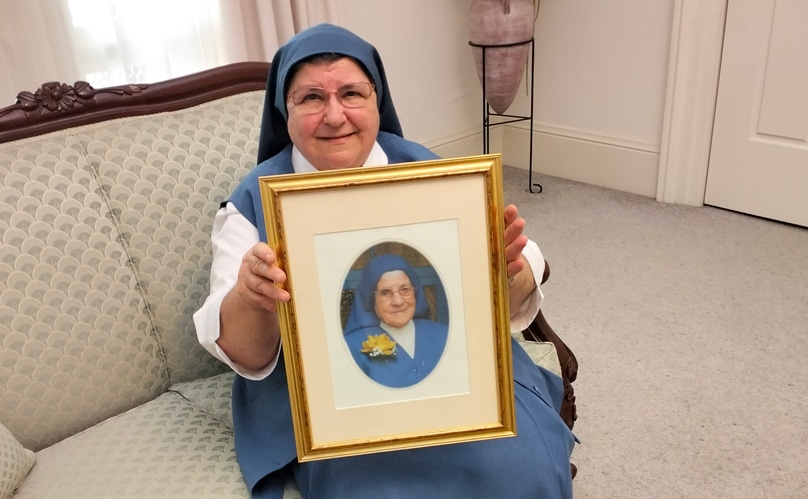
In the front room of her Strathfield convent Sr Maria Lalamea Vaohea folds her hands loosely in her lap and sings a Tongan hymn.
Sweet and pure, it carries her to her earliest memories of waking up early and, rubbing sleep from her eyes, joining her grandparents in their morning prayers.
Now far from her remote island home she has conquered homesickness, visa delays, culture shock and Sydney’s trying weather extremes with the same fidelity to Christ her congregation’s early members showed a century ago.
The 34-year-old religious is one of three young women from Pacific Island nations who are bringing new members to the Sister Disciples of the Divine Master after some years of vocational decline.
Entering novitiate programs in the Philippines or Rome, they are part of a pattern in the last few decades where people of former European missionary outposts throughout Oceania, Asia and Africa are reviving faith in their predecessor Christian countries.
Before Sr Lalamea entered the Sister Disciples—a congregation begun by the Italian Fr James Alberione in 1924 as a contemplative corollary to his media apostolates the Society of St Paul and Daughters of St Paul—she had no intention of leaving Tonga.
Now living at the large white brick building on Broughton Road in Strathfield, she is the newest member of her community and its youngest by decades.
She was 19, with seven younger siblings, when she first entered religious life and worked in a local parish and school.
“I was happy but in Tonga I felt too comfortable. There anything religious is a big thing, and people cook for you, they serve you at every major occasion,” Sr Lalamea said.
“As a religious I felt I should be serving the people. I started to think, is this the right congregation for me for the rest of my life?
“I was so busy I sometimes lacked time to pray and deep within me I felt something was missing.”
She first spent nine years in another order, before her heart was moved by a picture of a monstrance in a newspaper advertisement for the Sister Disciples.
Eucharistic devotion is key to their charism. In Sydney the entrance to the convent chapel is left slightly ajar to welcome the 10 sisters and their steady stream of visitors each day for adoration before the Blessed Sacrament exposed on the altar.
At some point Sr Lalamea will enter alone and stay, as all the sisters do, for 90 minutes.
It’s her precious time alone to reflect, pray, and sing hymns.
“Singing was the first thing that connected me to the Lord,” she says.

“From when I was very little, singing would lead me into feeling the presence of God.”
The congregation is both contemplative and apostolic and aims at living out a modern version of the women of the Gospel, with a three-pronged mission of serving Christ present in the Eucharist and in the liturgy, and supporting clergy.
The sisters’ habit is a blue and white ensemble or dress and veil, with a silver crucifix held by a long necklace.
In 1956 Sr Annunciata Stanizzi together with Sr Laurentina Bertero set out from her native Italy to establish the first community in Sydney, where today it operates a liturgical supplies store, and designs and produces vestments, altar linens and other items.
It expanded to Melbourne where six sisters still care for sick and retired priests, and later New Zealand and Samoa.
Polish-born Sr Anetta Szczykutowicz says they are present in about 30 countries on every continent, with new vocations coming mostly from Catholics born in Africa or Asia.
While not founded to be missionary “in the traditional sense” the sisters have St Paul’s missionary zeal in their DNA and go wherever they can be of service.
“Our founder had the intuition to evangelise through the means of social communications and so we have the Society of St Paul and the Daughters of St Paul,” Sr Anetta said.
“But he also wanted to evangelise through art and beauty, beautiful churches and liturgies and so our charism is to touch the hearts of people that way.”
Congregation secretary Sr Christina Pisani met Fr Alberione and the first Sister Disciple Mother Scholastica Rivata, and also lived with Mother Annunciata.
The latter, who died in 2008 was “always smiling,” would no doubt be delighted with its newest member.
“Vocations arise where the families pray together and the Islander communities make it a ritual for families to pray together in their homes,” Sr Christina said.
“Growing up in a Maltese-Australian family we used to do that too and Sunday Mass was a must.
“Vocations flourish where there is that kind of atmosphere.”

Speaking in a homily at a centenary celebration Mass in Sydney on 11 February, Bishop Terence Brady said the sisters are needed more than ever.
“In everything they do they offer a place to meet the Lord,” he said.
“We’re in a period when spiritual formation of the laity, religious and clergy is lacking and it is a great need in our church, so their presence and spirituality with its Eucharistic centre is even more important.”
At its most recent general chapter the congregation discussed its growth in the next century.
“We are thinking about ways in which we can reach out instead of waiting for the people to come to us, especially in today’s world where there is so much brokenness and even sadness in people’s lives,” said Sr Anetta.
“They search for God and don’t know how to find him, so going to the peripheries as Pope Francis says and promoting inculturality are things we would like to work more towards.
“We also want to form religious communities that are welcoming and composed of sisters from different parts of the world.
“This is being very much encouraged now but is something we have been doing in Australia since the beginning.”
Sr Lalamea and her family cried tears of joy the day her visa came through, freeing her to join the congregation.
Her transition to life in Australia, while good, has not always been easy.
“One very big challenge for me was that I had loved everything in the Philippines,” she says.
“I could not always understand things here, but I realised that now I am here I have to detach from what I had become attached to before.
“Since that moment I have grown a lot and received so much from the sisters including their great wisdom, which had I missed when my mind and heart were closed.
“Now I find joy and consolation in the community and in presence of each sister.”
